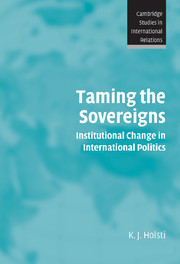Book contents
- Frontmatter
- Contents
- List of tables
- Preface
- 1 The problem of change in international relations: rhetoric, markers, and metrics
- 2 States and statehood
- 3 Territoriality
- 4 Sovereignty
- 5 International law
- 6 Diplomacy
- 7 International trade
- 8 Colonialism
- 9 War
- 10 International institutions: types, sources, and consequences of change
- References
- Index
- CAMBRIDGE STUDIES IN INTERNATIONAL RELATIONS
7 - International trade
Published online by Cambridge University Press: 22 September 2009
- Frontmatter
- Contents
- List of tables
- Preface
- 1 The problem of change in international relations: rhetoric, markers, and metrics
- 2 States and statehood
- 3 Territoriality
- 4 Sovereignty
- 5 International law
- 6 Diplomacy
- 7 International trade
- 8 Colonialism
- 9 War
- 10 International institutions: types, sources, and consequences of change
- References
- Index
- CAMBRIDGE STUDIES IN INTERNATIONAL RELATIONS
Summary
A general portrait of trade in Europe and the rest of the world in the seventeenth and eighteenth centuries combines the largely local and regional, land-based economies of continental Europe with a rapidly growing, conflict-ridden and competitive sea trade that centered on the Baltic, the Mediterranean, the Atlantic, and the seas of the East Indies. Most economic activity in Europe circulated around towns and villages, where production and exchange were largely local. The average person was hardly touched by economic activities that had a longer reach, for this was mostly trade in luxuries and only on occasion in staples such as wheat or hides. However, with improvements in shipping technology and the great explorations of the fifteenth and sixteenth centuries, long-distance seaborne trade grew rapidly. By the seventeenth century, trade routes around the world were well established and many of the developing monarchical states had become involved in the game of establishing settler colonies in the New World and trade outposts (factories) on the shores of Africa, India, and the East Indies.
While the volume of trade increased rapidly in the seventeenth and eighteenth centuries, it still remained a small fraction of any polity's total economic activity. One estimate is that it comprised only 1–2 percent of world GDP (Held et al., 1999: 154). There is thus a paradox: while international trade, though rapidly expanding, constituted only a small portion of a state's economic activity, it was a major source of conflict, competition, and war.
- Type
- Chapter
- Information
- Taming the SovereignsInstitutional Change in International Politics, pp. 211 - 238Publisher: Cambridge University PressPrint publication year: 2004
- 2
- Cited by



